Vasilis K. Papanikolaou
Resolving the Double Near-Far Problem via Wireless Powered Pinching-Antenna Networks
May 18, 2025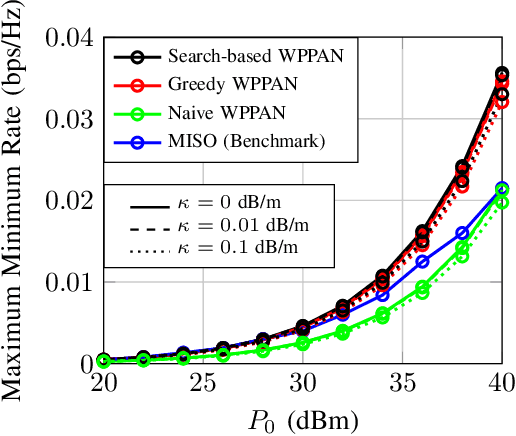
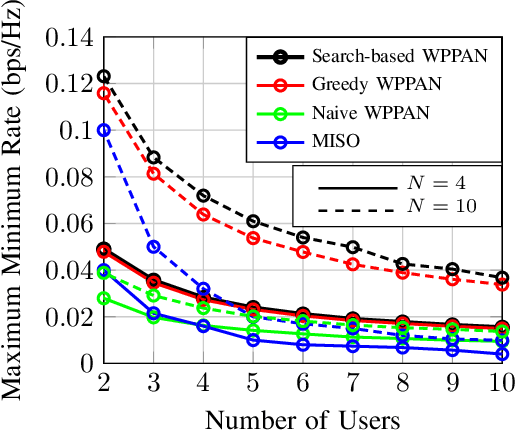
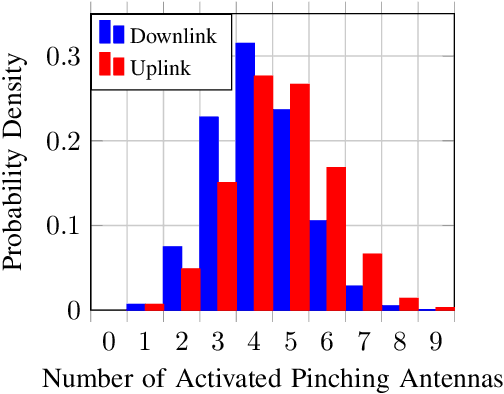
Abstract:This letter introduces a novel wireless powered communication system, referred to as a wireless powered pinching-antenna network (WPPAN), utilizing a single waveguide with pinching antennas to address the double near-far problem inherent in wireless powered networks. In the proposed WPPAN, users harvest energy from spatially distributed pinching antennas in the downlink and use the collected power to transmit messages in the uplink. Furthermore, to manage the combinatorial complexity associated with activating the pinching antennas, we propose three approaches of varying complexity to simplify the original resource allocation problem and then solve it efficiently using convex optimization methods. Simulation results confirm that the proposed WPPAN system effectively mitigates the double near-far problem by providing antenna resources closer to the users, thereby enhancing both downlink energy harvesting and uplink data transmission.
Pinching Antenna-enabled ISAC Systems: Exploiting Look-Angle Dependence of RCS for Target Diversity
May 03, 2025Abstract:We investigate a novel integrated sensing and communication (ISAC) system supported by pinching antennas (PAs), which can be dynamically activated along a dielectric waveguide to collect spatially diverse observations. This capability allows different PAs to view the same target from different angles across time, thereby introducing target diversity, which is a key advantage over conventional fixed antenna arrays. To quantify the sensing reliability, we adopt the outage probability as a performance metric, capturing the likelihood that the accumulated radar echo signal power falls below a detection threshold. In contrast to traditional ISAC models that assume deterministic sensing channels, we explicitly account for the look-angle dependence of radar cross-section (RCS) by modeling it as a random variable. We ensure the long-term quality-of-service (QoS) for communication users by enforcing an accumulated data rate constraint over time. We derive an exact closed-form expression for the sensing outage probability based on the distribution of weighted sums of exponentially distributed random variables. Since the resulting expression is highly non-convex and intractable for optimization, we use a tractable upper bound based on the Chernoff inequality and formulate a PA activation optimization problem. A successive convex approximation (SCA) framework is proposed to efficiently solve the formulated problem. Numerical results show that dynamically activating different PAs across time slots significantly enhances sensing reliability compared to repeatedly activating the same PA at a fixed position and conventional antenna selection schemes, respectively. These findings highlight the benefits of integrating outage-based reliability metrics and target diversity into ISAC systems using PAs.
Cramér-Rao Bounds for Integrated Sensing and Communications in Pinching-Antenna Systems
May 02, 2025


Abstract:Pinching-antenna systems (PASs) have recently emerged as a flexible, cost-effective route to large-scale antenna deployments envisioned for integrated sensing and communications (ISAC). This paper establishes the fundamental sensing limits of a bistatic PAS link by deriving closed-form Cram\'er-Rao lower bounds for the joint estimation of range and direction when a target is illuminated by pinching antennas placed along a dielectric waveguide and observed by a uniform linear array receiver. By rigorously preserving the amplitude and phase variations of each pinching antenna, as well as exploiting their non-uniform deployment, we gain valuable insights into the performance gain of PASs over conventional antenna arrays. Numerical results validate that the PAS-based ISAC can achieve centimeter-level ranging and sub-degree angular resolution with significantly fewer hardware resources than conventional uniform linear arrays. The derived bounds provide practical design guidelines for next-generation PAS-enabled ISAC systems.
Accurate EH Modelling and Achievable Information Rate for SLIPT Systems with Multi-Junction Photovoltaic Receivers
Aug 26, 2023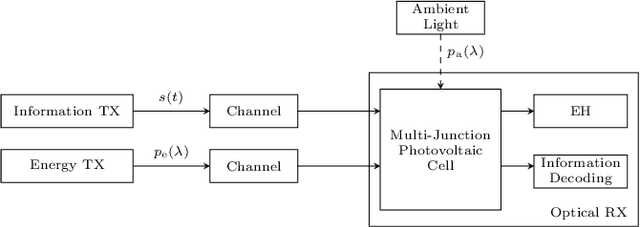
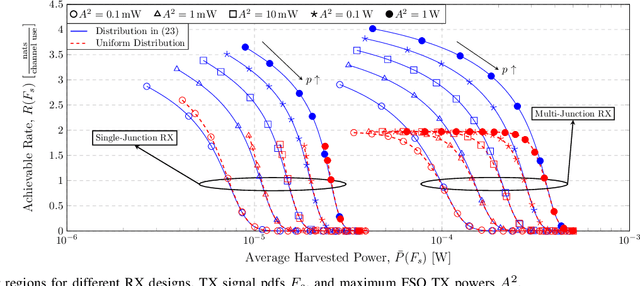
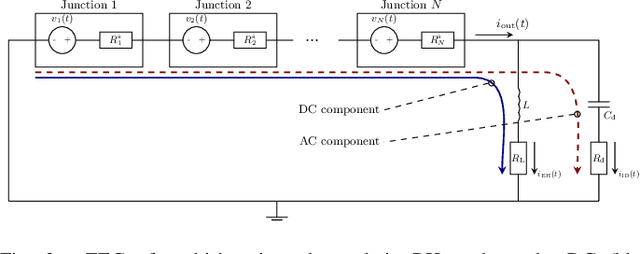
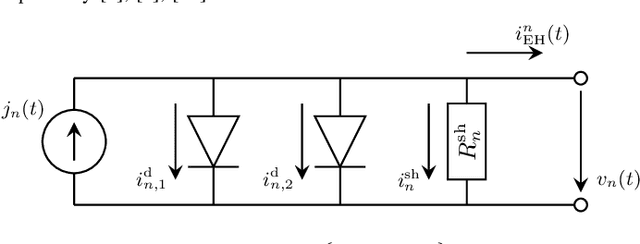
Abstract:In this paper, we study optical simultaneous lightwave information and power transfer (SLIPT) systems employing photovoltaic optical receivers (RXs). To be able to efficiently harvest energy from broadband light, we propose to employ multi-junction photovoltaic cells at the optical RX. We consider the case, where the optical RX is illuminated by ambient light, an intensity-modulated information free space optical (FSO) signal, and since the ambient light may not be always present, a dedicated energy-providing broadband optical signal. Based on the analysis of the equivalent electrical circuit of the multi-junction photovoltaic RX, we model the current flow through the photovoltaic cell and derive a novel accurate and two novel approximate energy harvesting (EH) models for the two cases, where the optical RX is equipped with a single and multiple p-n junctions, respectively. We derive the optimal distribution of the transmit information signal that maximizes the achievable information rate. We validate the proposed EH models by circuit simulations and show that the photovoltaic RXs saturate for high received signal powers. For single-junction RXs, we compare the proposed EH model with two well-known baseline models and demonstrate that, in contrast to the proposed EH model, they are not able to fully capture the RX non-linearity. Since multi-junction RXs allow a more efficient allocation of the optical power, they are more robust against saturation, and thus, are able to harvest significantly more power and achieve higher data rates than RXs employing a single p-n junction. Finally, we highlight a tradeoff between the information rate and harvested power in SLIPT systems and demonstrate that the proposed optimal distribution yields significantly higher achievable information rates compared to uniformly distributed transmit signals, which are optimal for linear optical information RXs.
Zero-Energy Reconfigurable Intelligent Surfaces (zeRIS)
May 12, 2023Abstract:A primary objective of the forthcoming sixth generation (6G) of wireless networking is to support demanding applications, while ensuring energy efficiency. Programmable wireless environments (PWEs) have emerged as a promising solution, leveraging reconfigurable intelligent surfaces (RISs), to control wireless propagation and deliver exceptional quality-ofservice. In this paper, we analyze the performance of a network supported by zero-energy RISs (zeRISs), which harvest energy for their operation and contribute to the realization of PWEs. Specifically, we investigate joint energy-data rate outage probability and the energy efficiency of a zeRIS-assisted communication system by employing three harvest-and-reflect (HaR) methods, i) power splitting, ii) time switching, and iii) element splitting. Furthermore, we consider two zeRIS deployment strategies, namely BS-side zeRIS and UE-side zeRIS. Simulation results validate the provided analysis and examine which HaR method performs better depending on the zeRIS placement. Finally, valuable insights and conclusions for the performance of zeRISassisted wireless networks are drawn from the presented results.
EH Modelling and Achievable Rate for FSO SWIPT Systems with Non-linear Photovoltaic Receivers
May 05, 2023
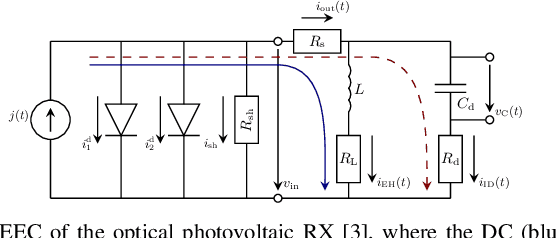
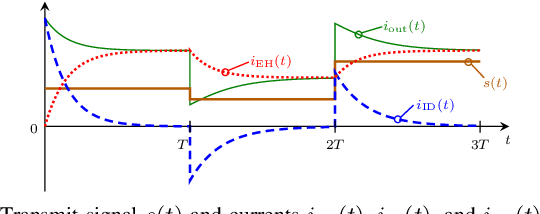
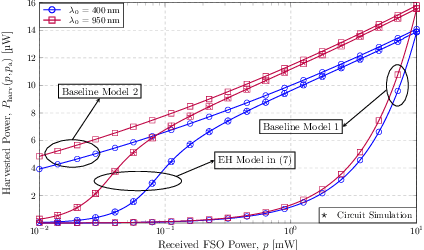
Abstract:In this paper, we study optical simultaneous wireless information and power transfer (SWIPT) systems, where a photovoltaic optical receiver (RX) is illuminated by ambient light and an intensity-modulated free space optical (FSO) signal. To facilitate simultaneous information reception and energy harvesting (EH) at the RX, the received optical signal is first converted to an electrical signal, and then, its alternating current (AC) and direct current (DC) components are separated and utilized for information decoding and EH, respectively. By accurately analysing the equivalent electrical circuit of the photovoltaic RX, we model the current flow through the photovoltaic p-n junction in both the low and high input power regimes using a two-diode model of the p-n junction and we derive a closed-form non-linear EH model that characterizes the harvested power at the RX. Furthermore, taking into account the non-linear behaviour of the photovoltaic RX on information reception, we derive the optimal distribution of the transmit information signal that maximizes the achievable information rate. The proposed EH model is validated by circuit simulation results. Furthermore, we compare with two baseline models based on maximum power point (MPP) tracking at the RX and a single-diode p-n junction model, respectively, and demonstrate that in contrast to the proposed EH model, they are not able to fully capture the non-linearity of photovoltaic optical RXs. Finally, our numerical results highlight that the proposed optimal distribution of the transmit signal yields significantly higher achievable information rates compared to uniformly distributed transmit signals, which are optimal for linear optical information RXs.
Machine Learning in Nano-Scale Biomedical Engineering
Aug 05, 2020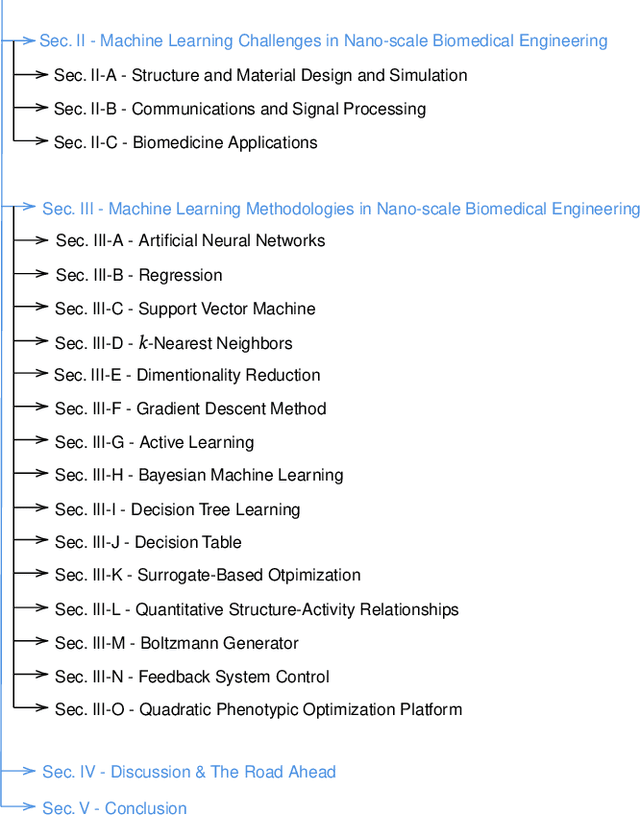

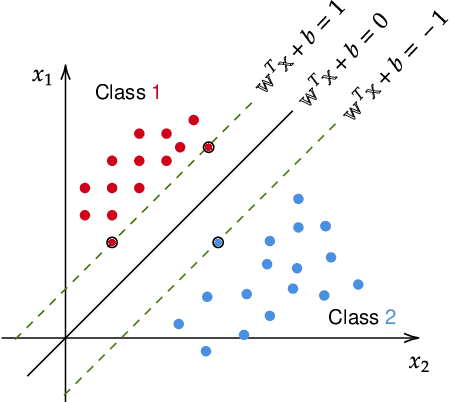
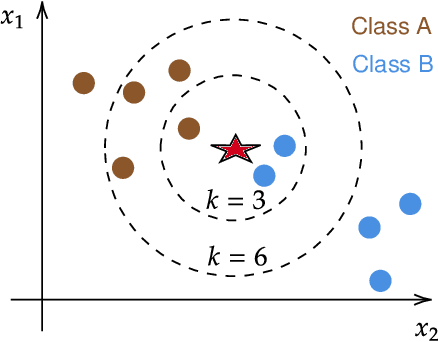
Abstract:Machine learning (ML) empowers biomedical systems with the capability to optimize their performance through modeling of the available data extremely well, without using strong assumptions about the modeled system. Especially in nano-scale biosystems, where the generated data sets are too vast and complex to mentally parse without computational assist, ML is instrumental in analyzing and extracting new insights, accelerating material and structure discoveries and designing experience as well as supporting nano-scale communications and networks. However, despite these efforts, the use of ML in nano-scale biomedical engineering remains still under-explored in certain areas and research challenges are still open in fields such as structure and material design and simulations, communications and signal processing, and bio-medicine applications. In this article, we review the existing research regarding the use of ML in nano-scale biomedical engineering. In more detail, we first identify and discuss the main challenges that can be formulated as ML problems. These challenges are classified in the three aforementioned main categories. Next, we discuss the state of the art ML methodologies that are used to countermeasure the aforementioned challenges. For each of the presented methodologies, special emphasis is given to its principles, applications and limitations. Finally, we conclude the article with insightful discussions, that reveals research gaps and highlights possible future research directions.
 Add to Chrome
Add to Chrome Add to Firefox
Add to Firefox Add to Edge
Add to Edge